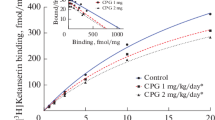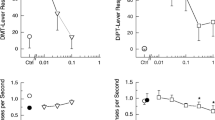Abstract
It was the aim of the present study to determine the affinities of four neuroleptics and five antidepressants for histamine H3 receptors. In rat brain cortex membranes, the specifically bound [3H]-M α-methylhistamine was monophasically displaced by clozapine (pKi 6.15). The other drugs did not completely displace the radioligand even at 100 µM; the pKi values were: haloperidol (4.91); sulpiride (4.73); amitriptyline (4.56); desipramine (4.15); levomepromazine (4.14); fluovoxamine (4.13); maprotiline (4.09); moclobemide (<4.0). The effect of clozapine was further examined in a functional H3 receptor model, i.e., in superfused mouse brain cortex slices preincubated with [3H]-noradrenaline. The electrically evoked tritium overflow was not affected by clozapine 0.5–32 µM. However, clozapine shifted the concentration-response curve of histamine for its inhibitory effect on the evoked overflow to the right, but did not affect the maximum effect of histamine. The Schild plot yielded a pA2 value of 6.33. In conclusion, clozapine shows an intermediate affinity and potency (as a competitive antagonist) at H3 receptors. The Ki value of clozapine at H3 receptors resembles its Ki value at D2 receptors (the target of the classical neuroleptics), but is higher than its Ki values at D4, 5-HT2 or muscarinic acetylcholine receptors, which according to current hypotheses, might be involved in the atypical profile of clozapine.
Similar content being viewed by others
References
Arrang JM, Garbarg M, Schwartz JC (1983) Auto-inhibition of brain histamine release mediated by a novel class (H3) of histamine receptor. Nature 302:832–837
Arrang JM, Garbarg M, Lancelot JC, Lecomte JM, Pollard H, Robba M, Schunack W, Schwartz JC (1987) Highly potent and selective ligands for histamine H3-receptors. Nature 327:117–123
Arrang JM, Garbarg M, Schwartz JC, Lipp R, Stark H, Schunack W, Lecomte JM (1991) The histamine receptor: pharmacology, roles and clinical implications studied with agonists. In: Timmerman H, Van der Goot H (eds) New perspectives in histamine research. Birkhäuser, Basel Boston Berlin, pp 55–67
Barnes JC, Brown JD, Clarke NP, Clapham J, Evans DJ, O'Shaughnessy CT (1993) Pharmacological activity of VUF 9153, an isothiourea histamine H3 receptor antagonist. Eur J Pharmacol 250:147–152
Bolden C, Cusack B, Richelson E (1991) Clozapine is a potent and selective muscarinic antagonist at the five cloned human muscarinic acetylcholine receptors expressed in CHO-K1 cells. Eur J Pharmacol 192:205–206
Bradford MM (1976) A rapid and sensitive method for the quantitation of microgram quantities of protein utilizing the principle of protein-dye binding. Anal Biochem 72:248–254
Coward D (1992) Aktuelle Aspekte zum Wirkungsmechanismus von Clozapin (Leponex®). In: Naber D, Müller-Spahn F (eds) Clozapin: Pharmakologie und Klinik eines atypischen Neuroleptikums. Schattauer, Stuttgart New York, pp 11–18
De Lean A, Hancock AA, Lefkowitz RJ (1982) Validation and statistical analysis of a computer modeling method for quantitative analysis of radioligand binding for mixtures of pharmacological receptor subtypes. Mol Pharmacol 21:5–16
Hill SJ (1990) Distribution, properties, and functional characteristics of three classes of histamine receptors. Pharmacol Rev 42:45–83
Kathmann M, Schlicker E, Detzner M, Timmerman H (1993) Nordimaprit, homodimaprit, clobenpropit and imetit: affinities for H3 binding sites and potencies in a functional H3 receptor model. Naunyn-Schmiedeberg's Arch Pharmacol 348:498–503
Kathmann M, Schlicker E, Göthert M (1994) Intermediate affinity and potency of clozapine and low affinity of other neuroleptics and of antidepressants at H3 receptors. Naunyn-Schmiedeberg's Arch Pharmacol 349 (Suppl):R95
Kenakin TP (1984) The classification of drugs and drug receptors in isolated tissues. Pharmacol Rev 36:165–222
Leurs R, Timmerman H (1992) The histamine H3-receptor: a target for developing new drugs. Prog Drug Res 39:127–165
Lipp R, Stark H, Schunack W (1992) Pharmacochemistry of H3 receptors. In: Schwartz JC, Haas HL (eds) The histamine receptor. Wiley-Liss, New York, pp 57–72
McPherson GA, Molenaar P, Raper C, Malta E (1983) Analysis of dose-response curves and calculations of agonist dissociation constants using a weighted nonlinear curve fitting program. J Pharmacol Methods 10:231–241
Schlicker E, Behling A, Lümmen G, Göthert M (1992a) Histamine H3A receptor-mediated inhibition of noradrenaline release in the mouse brain cortex. Naunyn-Schmiedeberg's Arch Pharmacol 345:489–493
Schlicker E, Behling A, Lümmen G, Malinowska B, Göthert M (1992b) Mutual interaction of histamine H3-receptors andα 2-adrenoceptors on noradrenergic terminals in mouse and rat brain cortex. Naunyn-Schmiedeberg's Arch Pharmacol 345:639–646
Schlicker E, Malinowska B, Kathmann M, Göthert M (1994a) Modulation of neurotransmitter release via histamine H3 heteroreceptors. Fund Clin Pharmacol 8:128–137
Schlicker E, Kathmann M, Reidemeister S, Stark H, Schunack W (1994b) Novel histamine H3 receptor antagonists: affinities in an H3 receptor binding assay and potencies in two functional H3 receptor models. Br J Pharmacol 112:1043–1048 and 113:657 (erratum)
Schwartz JC, Arrang JM, Garbarg M, Pollard H, Ruat M (1991) Histaminergic transmission in the mammalian brain. Physiol Rev 71:1–51
Schwartz JC, Arrang JM, Garbarg M, Lecomte JM, Ganellin CR, Fkyerat A, Tertiuk W, Schunack W, Lipp R, Stark H, Purand K (1992) French Patent Application, January 10, FR 2 686 084
Seeman P (1992) Dopamine receptor sequences. Therapeutic levels of neuroleptics occupy D2 receptors, clozapine occupies D4. Neuropsychopharmacology 7:261–284
Van der Goot H, Schepers MJP, Sterk GJ, Timmerman H (1992) Isothiourea analogues of histamine as potent agonists or antagonists of the histamine H3-receptor. Eur J Med Chem 27:511–518
West RE, Zweig A, Shih N-Y, Siegel MI, Egan RW, Clark MA (1990) Identification of two H3-histamine receptor subtypes. Mol Pharmacol 38:610–613
Author information
Authors and Affiliations
Rights and permissions
About this article
Cite this article
Kathmann, M., Schlicker, E. & Göthert, M. Intermediate affinity and potency of clozapine and low affinity of other neuroleptics and of antidepressants at H3 receptors. Psychopharmacology 116, 464–468 (1994). https://doi.org/10.1007/BF02247479
Received:
Revised:
Issue Date:
DOI: https://doi.org/10.1007/BF02247479




